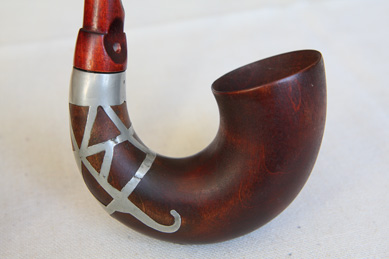Construction of Bagpipes
 Bag (bellows, air tank) of the bagpipes are traditionally made of entire animal pelt, animal such as goat, sheep, dog, rabbit or hare. Sometimes they are also made of uncut sheep's stomach. The pelt are usually well prepared, curried and sewed with the hair outside or inside (Pelt without hair is basically used in modern bagpipes).
Bag (bellows, air tank) of the bagpipes are traditionally made of entire animal pelt, animal such as goat, sheep, dog, rabbit or hare. Sometimes they are also made of uncut sheep's stomach. The pelt are usually well prepared, curried and sewed with the hair outside or inside (Pelt without hair is basically used in modern bagpipes).
Chanter is a melody pipe (melodic reed, hornpipe, fife, pipe) witch is typically made out of a hardwood (such as apple wood and maple). Bagpipes are mostly tuned to the keys of C and G. Sound is usually produced through the vibration of the reed. The reed formerly was made from wild reeds. Nowadays it‘s made out of bamboo wood. The reed generally is attached to the ashen or maple mouthpiece with either a thread or a tiny rub. The horn, which is gauge out of apple wood or pine wood is in the open end of chanter and works as resonator.
Drone (bourdon) is usually made of ash. Bagpipes can have from one to three bourdons. The first drone (or the only one) is tuned up fourth lover than the main sound of the chanter. The second drone which is longer should be tuned up quint lover than the first one. The third drone -duplicate the first one, but the octave lover. The drones of bagpipes are made of two pieces which easily slide into each other in order to create a better quality of sound (or to tune up the instrument perfectly). In addition, the open end tube of drone is decorated with a curved, splay and hollowed horn which is also the resonator at the same time. Both drones and horn are embellished with ornaments of rings, herbal and geometrical figures, or even encrusted with metals (tin or lead).
| Img. 1 from 10 | « Previous - Next » |

|
|
Blowpipe (blow stick) –a wooden tube designed for the air supplement into the bag. It is usually made of hardwood such as maple or ash, the wood which is also moisture resisting. In order to maintain the air in windbag, the end of the blower should be hammer down with a nail and one piece of leather and it works as a valve. The valve is pressured to the blower from the inside by inflated air and the inflated air stops itself from leaving.